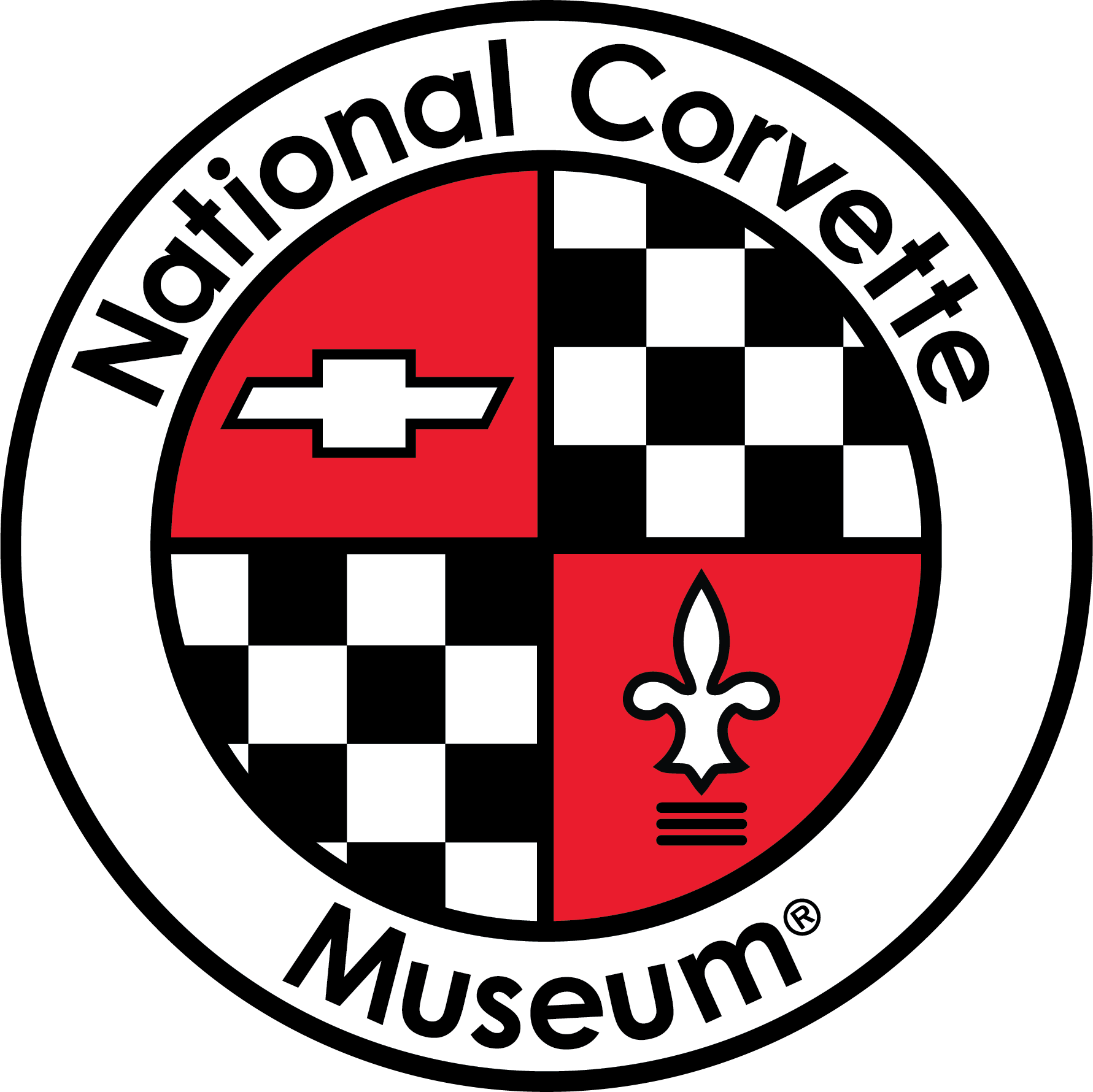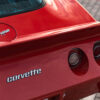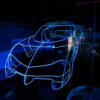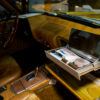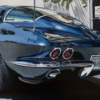As part of the National Corvette Museum’s 26th Anniversary Celebration, GM Bowling Green Assembly Plant Manager Kai Spande led a seminar to demystify the Corvette order and build process.
“In the factory we have some build restrictions. A few examples – we cannot make 100% coupes or 100% convertibles at any given time. The way we source our parts we try to predict what the fraction might be, and the different cars have different work content. The convertible top takes more time to install than the coupe. The workload in those specific stations are exaggerated a little bit. It’s not a problem if you do one. You end up slowing everything down if you do two, three, four in a row. When we schedule building of cars we typically never schedule convertibles back to back for that reason.”
Kai shared another restriction is colors. “We don’t build in batches. We do single piece flow in the order we need.” Kai elaborated that if there we an issue with the paint then they’d have many in a row that would have to be remediated, so it’s best to not have them in batches.
Other restrictions include various options. One option Kai shared was ‘E60’ or the front lift option. “It takes more energy or specific work content to install all those systems. It also takes parts. We don’t source every car to have every option. If you order a car with E60, which many more people did than we though, it can take longer to source that part.”
Kai also shared that supplier capacity can affect production. “We’ve had that situation with the current car – the high wing – we have a limited supply and many people want that. We have to match the supply base and sometimes we don’t predict what customers want in its entirety.”
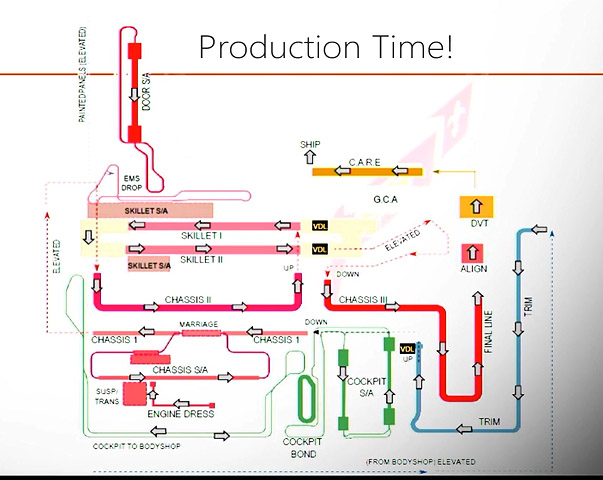
Kai then explained the various event codes and what they mean.
“What we’re going to talk about is what happens in the factory from the time people order cars to the time they’re delivered,” shared Kai.
| Dealer sees… | This means… | Translation |
| Event 3000 | Accepted by Production Control | Approved to be built |
| Event 3100 | Available to Sequence | Receives sequence number |
“When the plant builds cars, they’re all pre-determined what they will be and that cannot be changed due to the fact we have so many very expensive components we can’t keep an inventory. We could not have a warehouse full. We don’t want to be stuck with inventory that’s obsolete. We basically have our suppliers hold inventory and deliver it to the line in the order we need it.”
| Dealer sees… | This means… | Translation |
| Event 3000 | Accepted by Production Control | Approved to be built |
| Event 3100 | Available to Sequence | Receives sequence number |
| Event 3300 | Scheduled for Production | Receives targeted production date |
| Event 3400 | Broadcast to Plant | VIN is assigned, no further order changes allowed |
My car has been built… when do I get it? Elaborating on the Quality hold
| Dealer sees… | This means… | Translation | What’s left? |
| Event 3800 | Produced | Car has come offline | Quality checks |
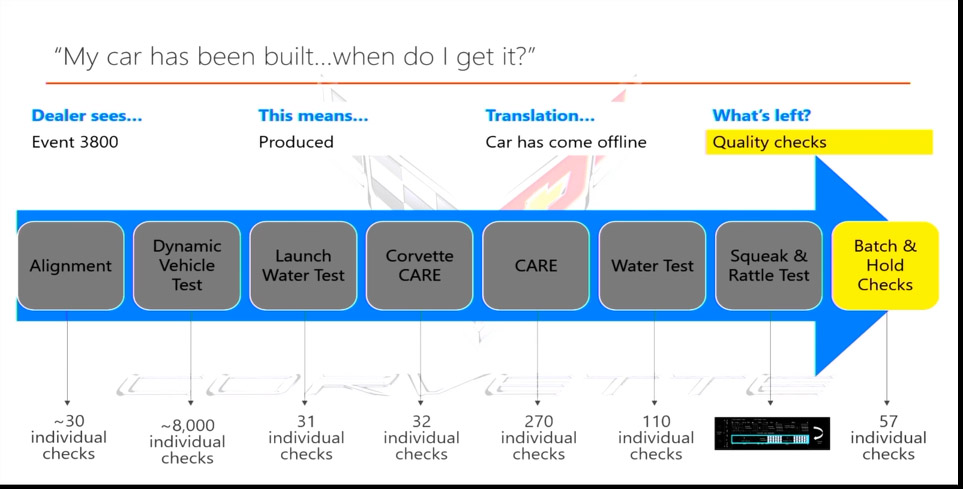
“The first thing that happens is alignment. The car is driven over an alignment pit with operators under the car doing the work with about 30 individual checks. The next step is Dynamic Vehicle Test (‘DVT’). Over 8,000 checks are done in DVT. The car will check a lot of things itself. In here we communicate with the vehicle and are looking to find things like are the antennas working properly for OnStar.”
After the DVT is what’s known as Launch Water Test, a water test that is much longer than the standard water test (more than 250% longer), a supplemental water test to the standard test, was proposed by the plant and is not performed elsewhere. “When we bring a new vehicle to production, trying to seal a car up is more difficult than you might think. For all intents and purposes this test really submerges the car so we can find leaks.” Kai also shared that this particular test they can earn their way out of by making sure they don’t have leaks and reduce it to an audit.
Corvette CARE consists of a closer look with 32 individual checks. “Some of these things are done in the process and are an added check, not a replacement. Other things we do here are 100% functionality checks. We might cycle the seats back and forth. We don’t just install the seat and hope it’s ok.”
The normal process is known as CARE (Customer Acceptance, Review and Evaluation), which is done on all cars and consists of 270 individual checks. “It’s a moving conveyor and on here we have a number of people looking at many aspects of the car, some of them predetermined, and some we elect to include.”
Following CARE is the normal water test with 110 different checks, and then the ‘Squeak & Rattle Test’. “At this point the car goes outside and goes down a track. As you enter the track you go through small bumps that jar the car back and forth. You go over ropes and rumble strips, cobble roads. We’re looking to see if the car is making any funny noises that we can pick-up. The individuals are very acute in their auditory skills so they can find things. 100% of the cars go through this.”

“Remember at this point we are still at a 3800. All the dealer knows is that the car has been built. All these processes that are going on we don’t change the status of the car from what the dealer can see.”
The next process is ‘Batch and Hold’ consisting of 57 individual checks. “This is a process that will eventually go away. The operator is taking a look to make sure buttons work, cycling things, open and close doors, looking at how the frunk closes, making sure we have good flushness, walking around the car and checking for functionality and appearance items. Some people may wonder why you’d put your hands on the car like that but it’s amazing what your fingers can pickup and many times you’ll see our operators use the back of their hand to pickup any discrepancies between two panels.”
“Once we get to the point we don’t have issues we start eliminating these one by one because we’ve proven they aren’t an issue and we simply audit them. Some people say trust then verify. You go verify and when you verify enough then you can start trusting. That’s how manufacturing is.”
Adding all the checks up it is more than 8,500 checks.
| Dealer sees… | This means… | Translation | What’s left? |
| Event 4000 | Available to Ship | Car is in Jack Cooper’s lot | Stripes, car cover |
| Event 4200 | Shipped | Car has left Cooper’s lot | Transportation and dealer checks |
“Depending on where you are in the country – if you’re out west they sometimes are shipped by rail. So they go to Toledo, Ohio and get on a rail, they go out west and they’re dispatched to dealers. By far, the majority of cars leave on these trucks and they go in batches geographically. We don’t ship in VIN sequence. We wait until we have cars that are grouped in a geographic area and we move them.”
Kai’s seminar concluded with a Q&A session composed of on-site event participants and virtual viewers. The seminars are available for viewing in their entirety online with purchase of ‘Virtual Anniversary’ registration. The fee is $20 and includes the Plant seminar, Corvette seminar, Hall of Fame Roundtable, Corvette Power with Paul Koerner seminar, Mobil 1 Tech Talk and Michelin Tire Design & Transformation seminar. Kai’s seminar is also available on the Museum’s YouTube channel and Facebook page.
